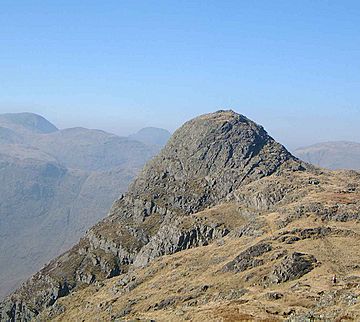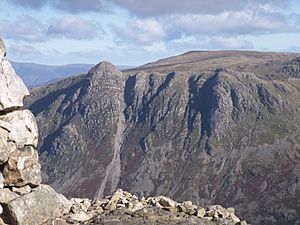Pike of Stickle facts for kids
Quick facts for kids Pike of Stickle |
|
|---|---|

Pike of Stickle from Loft Crag
|
|
| Highest point | |
| Elevation | 709 m (2,326 ft) |
| Prominence | c. 54 m |
| Parent peak | High Raise |
| Listing | Hewitt, Wainwright, Nuttall |
| Geography | |
| Location | Cumbria, England |
| Parent range | Lake District, Central Fells |
| OS grid | NY273073 |
| Topo map | OS Explorer OL6 |
Pike of Stickle, also called Pike o’ Stickle, is a cool mountain in England's Lake District. It stands 709 meters (2,326 feet) tall. You can find it in the middle of this beautiful national park, specifically in the Great Langdale valley.
It's one of three famous mountains called the Langdale Pikes, which are super popular in the Lake District. The other two are Harrison Stickle and Loft Crag. The name 'Pike of Stickle' is a bit funny because 'pike' means a pointy mountain top, and 'stickle' means a hill with a steep, rocky top. So, it basically means 'pointy pointy mountain'!
Contents
Mountain Shape and Location
The Langdale Pikes, including Pike of Stickle, form a rocky wall around a high, flat area called Thunacar Knott. Pike of Stickle is on the western side of this wall. Its rocky cliffs drop sharply to the south. This gives an amazing view from the valley floor, which is 2,000 feet below.
Loft Crag is the next mountain along this rocky line. Then come Thorn Crag and Harrison Stickle further to the east. Behind Pike of Stickle, to the north, is a dip called Harrison Combe. Beyond that are the two tops of Thunacar Knott. To the west, the land slowly goes down to Martcrag Moor. This is a wide, flat area with a few small lakes near the top. Martcrag Moor connects the Central Fells to Rossett Pike in the Southern Fells.
What the Mountain is Made Of
The back slopes of Pike of Stickle show signs of a type of rock called Pavey Ark Member. This rock is made of pebbly sandstone and breccia (a rock made of broken pieces). The front side of the mountain, facing Langdale, shows different layers of rock. These include the Lingmell Formation, Crinkle Member, and Bad Step Tuff. These layers are made of different kinds of tuff (rock made from volcanic ash), lapilli-tuff, and breccia. There are also layers of rhyolitic tuff and lava-like tuff.
Reaching the Top

Even though Pike of Stickle looks pointy, its top is wide enough for a good-sized cairn (a pile of stones). There's also a small flat area around it. From the top, you get fantastic views. You can see Loft Crag and Gimmer Crag close by. Bowfell looks impressive across Langdale. A large part of the Southern Fells is visible, and you can even see Skiddaw far away.
How to Climb Pike of Stickle
Pike of Stickle rises steeply from Langdale. Its narrow, pointy top gives excellent views of the valley's end. You can see the mountains of Bowfell and Crinkle Crags very well. People usually start their climb from Great Langdale. The New or Old Dungeon Ghyll Hotels are common starting points.
There are a few ways to climb the mountain. The most common path goes across the hillside from the New hotel. It passes between Thorn Crag and Gimmer Crag. Then, it turns left at the col (a low point between two peaks). A quieter way is by Troughton Beck. For this, you start from the Old hotel and walk about four kilometers (2½ miles) towards the valley's end. Then, you turn right and follow a zigzag path next to Troughton Beck. This route offers a unique view of the mountain from a less busy side. There used to be a direct path up the Stickle Stone Shoot. However, this route is very steep and has been badly worn away. It is no longer suggested for climbing up or down. You can also use the Langdale or Borrowdale sides of Stake Pass. This gives you access onto Martcrag Moor.
Ancient Stone Axe Factory
Pike of Stickle is famous for being the site of one of Europe's most important neolithic (New Stone Age) stone axe factories. The main places where they dug for stone are above the rocky slopes on the steep southern side of the mountain. The factory was built here because of a special type of rock called greenstone. This is a very hard volcanic rock that comes to the surface around the valley's head.
Signs of axe making have been found in many parts of Great Langdale. But the most discoveries have been made on the rocky slopes of Pike of Stickle. There is even a small cave near the top of the Stickle Stone Shoot. This cave was part of the ancient stone axe factory.


